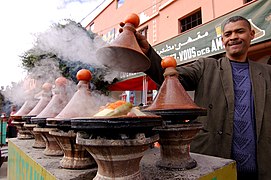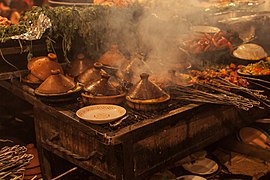Tajine
 A vegetable tajine dish as served in a London restaurant | |
| Alternative names | Tagine |
|---|---|
| Type | Stew or casserole |
| Region or state | Maghreb |
| Associated national cuisine | |
A tajine or tagine is a North African dish, named after the earthenware pot in which it is cooked.[1][2] It is also called maraq or marqa.
Pottery[change | change source]
The traditional tajine pottery, sometimes painted or glazed, is in two parts. There is a circular base unit that is flat with low sides and a large cone- or dome-shaped cover that sits on the base during cooking. The cover is designed to return all condensation to the bottom. That process can be improved by adding cold water into the specially designed well at the top of the lid.
Tajine is traditionally cooked over hot charcoal leaving enough space between the coals and the tajine pot to stop the temperature rising too quickly. Large bricks of charcoal are used, because they stay hot for hours. It can be cooked in a slow oven or on a gas or electric stove top, on the lowest heat necessary to keep the stew simmering gently. A diffuser, a circular utensil is placed between the tajine and the flame. That distributes the stove's heat evenly. European manufacturers have created tajines with heavy cast-iron bottoms. They can be heated on a cooking stove to a high temperature for browning the meat and vegetables before cooking.
Tajine cooking may be done using a slow cooker. Many ceramic tajines are decorative items as well as functional cooking vessels. Some tajines are intended only to be used as decorative serving dishes.
Gallery[change | change source]
-
Tajine potter
-
Tajine cooking
-
Electrical tajine
-
Stovetop cooking of tajine
-
Tajine with lamb, prunes and almonds
-
Algerian tajine with chicken, meatballs and olives
References[change | change source]
- ↑ "Nedroma (Oran)". Magasin pittoresque (in French). Paris: Jouvet & cie. 1859. p. 182.
- ↑ Uebersax, Mark A.; Siddiq, Muhammad, eds. (2012). Dry Beans and Pulses: Production, Processing and Nutrition. John Wiley & Sons. p. 516. ISBN 978-1-118-44828-1.






